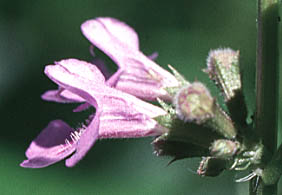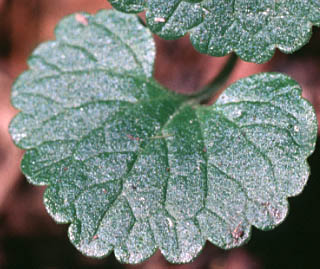
The photo above shows a close-up side view of the flower of ground ivy from near Crown Point, late May 2001. Note that the corolla is much longer than the hairy calyx, and that numerous long hairs may be found on the palate of the lower lip.

The photo above shows a close-up side view of the flower of ground ivy from near Crown Point, late May 2001. Note that the corolla is much longer than the hairy calyx, and that numerous long hairs may be found on the palate of the lower lip.
 The
photo at right shows the broad, kidney-shaped leaf of ground ivy with its broad,
rounded teeth along the margins. Note the broad, heart-shaped base.
The
photo at right shows the broad, kidney-shaped leaf of ground ivy with its broad,
rounded teeth along the margins. Note the broad, heart-shaped base.
Ground ivy is a perennial with lax stems arising from 10-40 cm high from slender stolons. The leaves are all found on the stems. The leaves are arranged opposite of each other. They are all petiolate, and the blades are rotund-cordate to cordate-reniform (kidney-shaped) with rounded teeth along the margins (See photo at right.). The base of the blade is heart-shaped and the blades measure about 1-3 cm long and are about as wide.
Several flowers may be found in each of the upper leaf axils. The calyx is narrow, measuring 5-6 mm long, with 5 toothed lobes, the upper teeth being longer. The corolla is tubular, 13-23 mm long, and blue-violet in color. Several purple spots may be found on the lower lip, while numerous smaller spots are found in the throat and lower, inner surface of the tube. The lower lip is much larger than the upper.
Ground ivy is found in moist woods, thickets, and often in shade, disturbed habitats, including yards, gardens, and parks.
Ground ivy is a native of Eurasia, but is now well established across much of the United States.
Ground ivy may be used as a ground cover, but it can be very aggressive. Some sources cite ground ivy as being edible, but this should be treated with caution as it is known that large quantities have killed horses. Historic accounts state that ground ivy may have been used as a poultice to reduce bruises and cancerous lesions, and to reduce muscular aches.